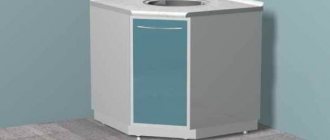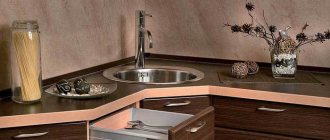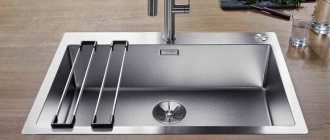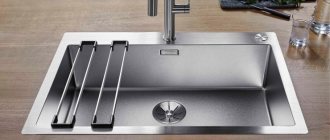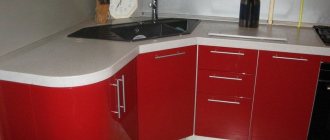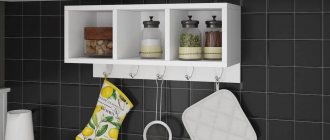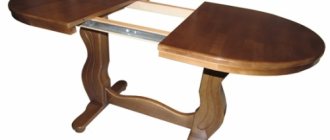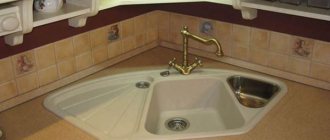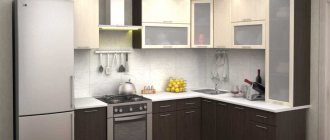The layout of kitchen furniture requires special attention, especially in old-style apartments, where extremely rational use of free space is necessary for a comfortable stay. One of the options for a compact and ergonomic kitchen arrangement would be to install a corner set. This furniture consists of two modules located along the walls, the space between which is filled by a corner cabinet under the sink. Its design, varieties, sizes and assembly methods will be discussed later in this article.
Example of a corner cabinet for a kitchen sink
Features of the design of a corner cabinet for the kitchen
Before purchasing this piece of furniture, you need to understand what it is.
Straight corner cabinet for sink in green color.
A corner cabinet is usually called a set that is located along the walls of the room. Its length depends on the preferences of the owner of the kitchen, as well as its space. It is also worth knowing that the sides of the headset must be positioned strictly perpendicular to each other:
- Compact due to angular shape.
- Performs a connecting function between furniture that is located along the walls.
- Large capacity compared to other kitchen furniture.
- Possibility of installing a sink. Consequently, there will also be pipes and other communications inside. They also often have space for a trash can.
- Coziness and comfort.
A corner sink cabinet will provide comfort and beautiful design to any kitchen.
Methods for installing a corner kitchen sink
Most modern people with simple knowledge can install this object:
- we fasten the side parts with the bottom part;
- installation of a corner structure;
- we fasten the connecting components;
- installation of legs (if provided);
- We install doors and handles.
At the location of the washing unit, all communications necessary for its functioning are located.
Additional Information. When purchasing any furniture, a diagram is included, with which installation is quite simple. There are two installation methods: mortise and overhead.
Varieties
There are two types of corner kitchen sinks: L-shaped with an acute angle, these sections are also called attached, and a kitchen cabinet with a beveled corner. They differ in internal overall dimensions, design, quantity and method of opening the doors, and ease of use.
Corner cabinet for the kitchen under the sink, main overall dimensions.
| Type of corner segment for sink | Corner cabinets for kitchen sink dimensions |
| L-shaped bedside table with an acute angle, attached |
|
| Kitchen cabinets with beveled corners. Equilateral dimensions (adjacent to the wall) - from 85 cm to 90 cm. The height of all types of segments varies from 85 cm to 90 cm. For ease of cleaning, the segments are equipped with legs (up to 10 cm), which can be covered with a furniture strip. It is attached to special clips. |
|
Custom-made kitchens may have slightly different overall dimensions.
Mortise invoice
To install it in the tabletop, it is necessary to make a hole according to the dimensions of a specific model, while the edges of the product (edging or wing) extend onto the surface of the table and it rises. It is important that the joints are well treated with sealant.
Built-in sink in the kitchen
Corner cabinet for kitchen under sink
Invoice
This is a traditional type that is installed instead of a countertop. The size of the sink matches standard cabinets. The kit includes not only a sink, but also special mounting sockets and platforms for installing a mixer.
One of the options for an overlay design is a model with a wide wing that connects to the main tabletop. This sink is quite massive, but allows you to usefully fill the entire corner.
Overhead corner sink
The downside of this installation method is that water gets into the space between adjacent modules, so the furniture is exposed to the destructive effects of moisture every day.
Surface-mounted stainless steel sink
Mortise
Such kitchen sinks do not rise above the countertop (sometimes they are even recessed). Often the surface of the cabinet is made of artificial stone. This type of sink is the most expensive, and the installation method is the most labor-intensive.
Undermount kitchen sink with two bowls
Cabinet for kitchen sink (mortise method)
If the sink is completely recessed into the countertop, then there is no protrusion. The seam around the perimeter of the sink must be reliably sealed. Italian kitchen sinks, by the way, come in both overhead and mortise.
Cabinets with closed fronts
A common storage option is to use closed facades. With their help, you can place more necessary things, and you don’t have to constantly monitor the perfect order. Remember that it is better to dilute closed facades with stained glass windows and patterns.
Corner sink cabinet with closed fronts.
Selecting size and shape
In order to make the right choice of corner cabinets, you need to know their features, advantages and disadvantages. In attached sections with an acute angle, the internal space is smaller than that of the second type of cabinets. They can be equipped with two doors or one that opens two sections at once (accordion door). The convenience of the second option is that access to the far corner inside the section is simplified. A corner cabinet for a kitchen sink with a beveled corner is more spacious, as it has a larger volume. It is possible to install a larger sink. In addition, they are convenient in terms of use, since the beveled corner makes it easier to access the sink. The disadvantage is that it only has one small door.
The problem area of corner sections under the sink is the countertop. The standard canvas has a width of 60 cm. In the case when postforming, a laminated tabletop is used, there is a seam on the corner segments. This point is not relevant for cast countertops made of artificial stone. Corner overhead sinks are sold that fully correspond to the dimensions of the working surface of the cabinet. Or, for this section, purchase a special postforming with a width of 120 cm.
What else needs to be taken into account when choosing a corner segment:
- kitchen area. A section with a beveled corner takes up more space;
- You should immediately decide on the size and shape of the kitchen sink.
You don’t have to purchase it right away, but you need to select a model and download the technical drawing on the Internet. When you purchase a cabinet, take it with you and show the sales consultant the drawing. This will help avoid possible mistakes;
- material used to make kitchen and countertops. Remember that laminated boards are most prone to swelling from moisture. Therefore, it is desirable that the surface of the tabletop be seamless;
- general style and interior design;
- decide whether additional elements will be located in the corner element: chopper, filters, flow-through heater. In this case, it is reasonable to give preference to a segment with a beveled corner.
Only by summing up all these points can you make your choice.
Straight cabinet
An ordinary floor cabinet, which has one blank door - a false panel. This option is the most budget-friendly, and therefore the most common. But using it is not very convenient - there is a lot of free space, but it is difficult to reach it.
The standard dimensions of such a cabinet for a sink are 100 by 60 cm along the countertop. At the same time, the module itself will be slightly smaller - 95 by 55 cm. This is due to the fact that the tabletop should hang slightly in front, on the side and even sometimes in the back.
With this situation, the size of the facade is 71.6 by 39.6 cm. We must not forget about the internal component - on the inner side of the cabinet they make a cut under the sink, or rather, its communications.
In this case, the dimensions are individual, but most often this hole is about 25 by 15 cm. If the pipes require a larger hole size, then it is better to make the side side not solid, but assembled from planks.
L-shaped cabinet (acute angle)
Here the cabinet is equipped with a special transforming door, thanks to which it is very convenient to use the interior space. Moreover, in terms of measurement, this is the most flexible option.
In this case, one or two back sides of the cabinet are left hollow - this depends on the number of connections and wiring. The dimensions of a standard cabinet are 92 by 92 cm. In addition, two doors with sides of 71.6 by 39.6 cm are required.
Such modules can be easily customized by simply trimming one of the sides. It is worth remembering that a wide door is always hung on the side, and a light door is always hung on it (the first door). If you do otherwise, the facade will sag over time.
Trapezoidal cabinet (with beveled corner)
The largest and most cumbersome version of a corner kitchen table for a sink. It is advisable not to install it in small rooms, as it takes up too much usable space. For this reason, they are appropriate only in spacious rooms with a classic design. The options listed above look better in modern kitchens.
If the trapezoid cabinet seems too rough and large, then you can choose a concave design for the door and table top, but this will not solve the problem of bulkiness. It is in this option that the problem of a small door and a huge free space inside is very acute. The dimensions of the module are 90 by 90 cm, with the door being 71.6 by 47 cm.
Another disadvantage of such a cabinet is that an ordinary 60 cm countertop does not cover the entire surface, so it has to be joined, and this threatens water from the sink getting into the seams and swelling of the material. Such a joint is made either at the sink level or with the help of a small supporting superstructure.
Of course, if you use another material, for example, artificial stone or plastic, then this problem can be avoided. But the cost will be completely different. Manufacturers are trying to solve this problem by producing special pentagonal countertops, but so far their selection is very limited.
Size calculation
To choose a vanity unit, you need to consider several factors, including:
- features of the kitchen - its area and layout;
- features of the sink - shape, size and even installation method;
- what will be stored inside, and how often you need to get into it.
The standard sizes for each type of cabinet were described above, but you can create anything you want individually.
Today, designers are trying to deviate from standards and create individual solutions, since they are the most comfortable and optimized. For example, for a long time the standard tabletop height was considered to be 85 cm, and the adjustment was a maximum of a couple of centimeters to adjust the set to uneven floors.
Now you can adjust the height by 10 cm or even more to make your stay in the kitchen as comfortable as possible. There is even a small but visual drawing telling you what height of a kitchen unit with a sink in the corner is suitable for what height. The standard width of the door (not transformer) of a corner bedside table is 40 cm. You can make it 30 cm, but this will significantly reduce access to the space and stored products. Is it worth it?
Of course, you cannot choose a built-in sink larger than the countertop. You have to monitor both the length and depth of the product. Most kitchen sinks are designed to fit into a 60cm deep worktop, with the sink itself only taking up 48-50cm of this space as clearances need to be provided.
Dimensions of corner floor cabinets
The standard dimensions of a corner washing table are 90 cm for each side adjacent to the wall, that is, 90x90 cm. In this case, the underframe is spacious enough for both rectangular and trapezoidal shapes. The load on the load-bearing elements is distributed evenly, which contributes to a long service life. Dimensions of the remaining parts for the 60 cm tabletop:
- The side walls adjacent to the straight elements of the headset are 50 cm wide, the height depends on the project (in most cases it is 70-90 cm).
- The door width is 40 cm, the height corresponds to the design value.
Larger non-standard version – 98x98 cm:
- Depth of side elements – 51 cm;
- Door width – 47 cm;
The most compact solutions have dimensions of 60x60 cm along the corner walls, while the size of the remaining parts is as follows:
- Depth 30 cm;
- Door width – 40 cm.
With such dimensions of the lower frame, it is only possible to install a full-fledged sink in a trapezoidal structure.
Manufacturing materials
There are several basic materials that manufacturers use:
- Natural wood - a wooden cabinet is durable, reliable and beautiful, especially when adding figured carvings. However, caring for it is quite problematic.
- Chipboard (chipboard) is a popular material for inexpensive furniture. It does not require maintenance, and its main advantage is a large selection of colors.
- MDF is a more environmentally friendly and reliable material. It is not afraid of high temperature and humidity.
- Multiplex - thin wooden strips of different types, glued in different directions.
Manufacturers may offer corner cabinets from different materials depending on the price.
Important! In addition to cabinets made from one material, those assembled from combined materials are popular.
Types of countertops
The countertop is the working surface of the sink cabinet. It can be intended only for embedding a sink, or at the same time serve as an additional area for cooking and placing dishes.
The material of the tabletop should be quite practical, resistant to mechanical damage and not afraid of moisture.
Laminated chipboard and MDF best meet these requirements. Natural materials - wood and stone - are not practical and require special care, so it is not advisable to use countertops made from them in furniture for sinks.
If you want the tabletop to retain its appearance for a long time and minor scratches not to be noticeable, choose matte products.
Filling
Don't forget to take into account the interior contents of the cabinet. If technical components are concentrated there (chopper, water filter, flow-through heater), then it is wise to use a cabinet with a beveled corner, since it is more spacious. When you plan to use it for storage, both options are suitable. You just need to decide on the dimensions of the stored items. The height of the shelves will depend on this.
In an attached segment with an acute angle, it is possible to use special pull-out baskets and rotating shelves, this is quite convenient.
If a garbage container is located in the corner segment, then when planning the interior space, it is better to know its size in advance. Then you can rationally place additional shelves.
Accessories
The classic solution for a composite module with an internal corner involves the presence of two cabinets with separate doors. Swing models are more practical in this case.
There are options with an accordion door, which is convenient if there are combined shelves inside. It will provide a good overview of the contents of the cabinet and easy access to pipes, filters, etc.
Large online stores of home goods (for example, Leroy Merlin, IKEA) offer a wide selection of modules with or without a countertop, as well as complete with a sink.
Inner space
The internal storage system can be represented by several types:
- Shelves. Conveniently divides the space into several zones.
- Baskets and nets. One of the most convenient ways to store small items.
- Drawers. Suitable for storing any kitchen utensils, especially cutlery.
The interior space of the sink can be decorated in different ways.
Washing options for corner segments
There is a wide range of sinks on the market, including corner sinks.
What types can be used:
- corner sinks - for cabinets with a sharp corner, rectangular sinks are suitable. For the second type, with a beveled corner, the choice is wider, since the working surface is larger;
- round sinks 50, 60 cm, these are standard sizes. It should be remembered that a section with a sharp internal corner is also suitable for sink 50;
- direct sink - most often manufacturers produce them in lengths of 60 cm (600 mm) and 80 cm (800 mm). The depth depends on the type of sink (countertop or mortise) and shape.
A floor-mounted corner cabinet for a sink, its choice, is directly related to the size and shape of the sink.
Methods for installing a corner kitchen sink
Depending on the method of installation of the sink, there are:
- overhead - the simplest method: the sink is installed in a special recess with sides. In this case, the size of the sink must exactly match the parameters of the furniture;
- mortise - the sink is placed in a pre-cut hole corresponding to its size. The joints between the furniture body and the sink are covered with a gasket made of rubber sealant or silicone;
- under-table - a variant of an overhead sink, in which the bowl is installed not on top, but below the countertop and is supported by a special structure;
- integrated - this is the most expensive, high-quality and reliable installation method, in which the sink and countertop are made of the same material and form a single whole. There are no gaps or joints in this kit. Due to the high cost, such products are made to order.
Shapes and sizes of kitchen sinks for corner cabinets
Traditional sink sizes are:
- 50x50 cm;
- 40x50 cm;
- 50x60 cm;
- 60x60 cm.
Their depth can vary from 15 to 25 cm. If the kitchen does not have a dishwasher, it is best to choose a deeper product - from 16 cm, it is more convenient to wash tall pots, plates and other containers.
Many manufacturers offer sinks of non-standard sizes, although the furniture for them will have to be made to order.
Please note that the distance from the edges of the sink to the sides must be at least 5 cm, otherwise water will splash.
The shape of the sink is chosen based on personal preference. Modern sinks can be square, rectangular, oval, round and even asymmetrical. But the most practical ones turned out to be rectangular and square options with smoothed corners - you can wash almost any dishes in them. It is not recommended to purchase a sink with sharp inner edges - dirt will accumulate there, which is difficult to clean.
Kitchen sink equipment
Most housewives are accustomed to the classic single bowl. If space allows, you can use a multi-section sink - a design with two or more compartments. It allows you to perform several actions at once. For example, simultaneously wash dishes and fruit, defrost food and store accessories.
The number of bowls is usually no more than five; the most common option is with two sections.
It would be good if the sink was equipped with special wings - corrugated side surfaces for drying dishes.
What are corner sinks made of?
Pay attention to the material of the product. For the production of kitchen sinks the following are most often used:
- Stainless steel is an economy-class material characterized by high performance characteristics. The only drawback is the noise when washing;
- artificial stone - products made from it are durable, do not make noise and look impressive;
- natural stone is a very expensive and heavy material. It is mainly used to create luxury interiors for individual orders.
There are sinks made of porcelain, ceramics and even wood, but they are all expensive and not very practical.
Preparing for work
Making a kitchen sink cabinet consists of several successive steps:
- The choice of design depends on the configuration of the room, the presence of other furniture, your wishes for appearance and consumer properties.
- Taking measurements of the free space in the kitchen that the sink should occupy.
- Making a preliminary sketch , sketch and precise drawing.
- Calculation and preparation (purchase, self-production) of assembly units: doors, sides, countertops.
- Preparing the necessary set of tools and purchasing the missing equipment.
- Assembling the cabinet , including installation of internal parts.
- Installing a countertop with a sink.
- Supply and connection of communications.
The work is completed by adjusting the gaps between the doors and checking the functioning of the water supply and drainage elements.
Preparation of diagrams and drawings
A furniture sketch precedes the construction of a drawing. The figure shows the desired design in relation to the surrounding kitchen space.
When calculating the exact dimensions, take into account :
- Free space in the room. It is advisable that the cabinet take up all the available space between the set and the walls.
- Sink dimensions. Installing mortise or under-table models does not affect the vertical dimensions, but requires leaving a border of at least 60 mm in the tabletop.
- Sink installation method . Overlay products increase the height of the furniture, so the vertical walls are made lower by this distance in order to maintain the overall height of the entire set.
- The method of connecting communications , often pipes, greatly influence the location and size of the internal shelves. If it is possible to correct the communication scheme, it is better to do this in advance.
The standard size of a cabinet for a sink is considered to be a height of 820 mm , excluding the countertop. The parameter can be easily changed within 40x50 mm using adjustable legs. It is easy to purchase ready-made parts with processed edges for these dimensions. The depth and width of a homemade bedside table are chosen based on the available space in the kitchen.
Dimensions are applied to the sketch, thus obtaining a drawing.
The thickness of laminated chipboard sheets is 16 mm, OSB from 9 to 12 mm, wooden boards according to measurements. These dimensions must be taken into account when designing.
Tools
For production you will need:
- drill with variable speed control or screwdriver;
- a jigsaw or a hand saw with a fine tooth, but the best option is achieved when sawing with an electric miter saw;
- hammer;
- pliers;
- screwdrivers or screwdriver bits;
- tape measure, long ruler, marking pencil.
To process wooden parts and ends of laminated chipboards before gluing the edges, it is advisable to have an electric sander; it will greatly reduce the time required to complete operations compared to manual work.
Self-adhesive edges are installed at home using a household iron.
Materials
Sink cabinets are made from a variety of materials:
- Tree. The products look expensive, but making such furniture is much more difficult, since you have to glue slabs from several boards and sand them in one plane. It is recommended to purchase ready-made furniture panels and adjust them to the desired size. Mandatory treatment against getting wet will be required.
- Laminated chipboard is easy to use, the thickness of the parts is stable, and large areas are reliably protected by the coating. Careful alignment and gluing of the edges will be required.
- Plastic. It is not afraid of moisture, but gradually loses its original color and is susceptible to damage from mechanical stress or scratches from the claws of pets.
- Glass. Glass doors of the required sizes can be ordered in any workshop, but it should be taken into account that the material should not be transparent, as otherwise the communications and contents of the cabinet will be visible.
It is not advisable to use plasterboard to build a cabinet; even gypsum boards of the GKLV brand quickly lose their shape due to the inevitable contact with water in the kitchen.
To assemble the structure you will need:
- fastening elements: self-tapping screws, euroscrews, couplers;
- hinges for hanging doors;
- legs and arms;
- shelf supports;
- self-adhesive edge;
- paints and varnishes for wooden bedside tables.
As a rule, such a set is sufficient for assembling furniture; missing elements are purchased as needed.
Drawings of corner cabinets for sinks
If you do not take into account the principle of building in a sink bowl (and it can be overhead or mortise), then there are three designs of a corner cabinet for sinks:
- Straight side corner table. In fact, it is a standard kitchen module with one “muffled” door - a false panel. The most common option in modular kitchens.
- L-shaped corner table-pedestal. The most flexible option in terms of resizing. Most often it is equipped with a transforming door, which significantly expands access to the inside of the cabinet.
- Trapezoidal table-pedestal for sink. The most bulky “classic” version of a corner cabinet for a sink. It is not recommended to install it in small kitchens, as it “eats up” a lot of usable space.
Drawings of an L-shaped corner cabinet for a sink
For a table-cabinet of this design, you can give two drawings, with different designs of the back walls. The first drawing is suitable if all communications “enter” from the corner on one side.
Drawings with dimensions of an L-shaped corner cabinet for a sink
If you plan to install counters in the cabinet under the sink, connect a separate filter, and generally plan a lot of wiring (for a dishwasher, washing machine), then it is better to leave both sides hollow.
Drawings with dimensions of a corner L-shaped cabinet for a sink
The dimensions of the corner sink cabinet in the standard version are 920x920 mm (taking into account the rear overhang of the countertop 970x970 mm). In this case, two doors measuring 716x396 are installed.
The module can be modified by cutting the size of any of the sides. In this case, the wider door is always attached to the side, and the lighter one is attached to it. Otherwise, the transforming door will begin to sag over time.
Drawings of a corner table-cabinet for an “added” sink
Typical dimensions of a corner cabinet for a sink of this design are 1000x600 mm along the countertop. At the same time, the module itself, taking into account the overhang of the tabletop in front, behind and from the corner, has dimensions of 950x550. The dimensions of the facade with these dimensions and the standard height of the kitchen modules are 716x396 mm.
Drawings with dimensions for an attached corner sink cabinet
Usually, to supply water supply communications, a cut is made in the inner side of the cabinet under the sink, approximately 250x150.
If the pipes go deeper, then it is better to make the sidewall not solid, but to “assemble” it from planks.
Drawings of the “trapezoid” sink table
Corner sink cabinets with a characteristic trapezoidal shape look good only in spacious kitchens with a classic design.
Drawings with dimensions of a corner cabinet for a trapezoid sink
For modern kitchen design, the design of the first two variants of cabinet sinks is better suited.
The design is somewhat softened by the radius design of the door and tabletop, with a concave shape.
But at the same time, the kitchen module itself remains very bulky, voluminous, with limited access inside. With its overall dimensions of 900x900 (including tabletop overhangs), the door is 716x470.
Another disadvantage of this kitchen module is that it requires additional joining of standard worktops with a width of 600 mm. And this means the presence of an additional seam in the sink area, which can potentially swell from moisture.
The joint is made at the same level as the sink or through a superstructure.
The joint can be avoided if you order a countertop made of artificial stone or plastic. But this leads to an increase in the cost of the entire kitchen.
There are also pentagonal, ready-made post-formed countertops on sale specifically for trapezoid sinks. But their range is limited.
Types of corner tables for sinks
There are two main types - rectangular and trapezoidal. They can differ from each other in appearance, design, type of sink (number of sinks, material of manufacture, installation method) and ease of use.
- Rectangular models. Externally, it is a floor cabinet, the side edges of which are adjacent to wall modules. The pairing of the side elements occurs at an angle repeating the junction of the walls (90°). The most common and easy to manufacture option, however, it is somewhat deprived of internal space, which affects functionality and is not always convenient to use. Access to the internal contents is possible either through one (the opposite side is made blind in this case) or through two adjacent doors. If there is only one door, it becomes difficult to access objects located in the adjacent part, but if there are two of them, then it will not be possible to open both at once in a normal way. One of the most successful solutions in such cases is to install a double door. In fact, these are the same two doors, only connected to each other by canopies.
It is better to make double doors in a classic corner wardrobe - Trapezoidal wardrobe . A large pentagonal-shaped cabinet, the front part of which has a beveled edge that overlaps the rectangular junction of the side modules. Such solutions are characterized by greater capacity and provide convenient access to the internal contents. However, trapezoidal washing tables are more expensive, take up more space and look somewhat cumbersome in small kitchens. In addition, convenient access is only possible to objects located in close proximity to the front of the bedside table. It is very difficult to get to its far corners through a 45 cm wide door.
Either a mortise or overhead sink with one or two sinks and additional space for drying dishes can be installed on top of the base. The most common material used for manufacturing is stainless steel. Nowadays, mortise metal models are available and popular; they are quite spacious, strong and durable. Overhead stainless steel options are used extremely rarely, which cannot be said about monolithic solutions made of artificial stone.
How to make it yourself
If you have certain skills, you can assemble the corner segment yourself. A laminated board is the best option for a DIY kitchen and is the easiest way to make one.
The sequence of actions is as follows:
- decide on the type of section. To do this, consider the size of the room and what will be located inside the segment;
- Check out the main types of sinks for corner cabinets. Both types are suitable for sink 50. Choose the best option and download the sink drawing;
- think over and sketch a drawing of the cabinet with detailed dimensions;
- With a drawing, contact a company that cuts laminated boards to size. They will also tell you where to buy components and end tape;
- When all the blanks are available, you can assemble the corner segment. To begin with, install the sidewalls and attach them to the bottom of the cabinet. Next, the connecting strips are installed and secured. Then the legs are screwed on. Mark and cut out recesses for door fastenings. They install them and hang the doors. Depending on the type of sink, overhead or mortise, prepare the countertop in order to mount the sink. To make a hole in the tabletop, use a jigsaw. First make markings on the countertop according to the shape of the sink. A mortise sink is installed only with sealant. It is important to follow the assembly sequence.
So, the floor corner segment for the sink is an important element of the kitchen furniture set. It carries a significant functional load. There are two main types of cabinets. Depending on a number of the above facts, they choose one of them. A significant element is the shape and size of the sink and internal filling. When choosing a material, the interior design plays a major role.
How to make a corner cabinet yourself
The kitchen is probably the favorite place to spend time for both adults and children. It’s so nice to have dinner with your family, gossip or just sit with a cup of coffee. Therefore, everything on it should be perfect (in the opinion of specific owners). If you cannot find a suitable design, it can be made. This is also possible with a sink cabinet.
This place is almost always used for installing a sink, which means that a siphon, pipes, and technical communications will be hidden in the cabinet.
First of all, you need to decide:
- what type of product needs to be invented, its dimensions;
- view and familiarize yourself with information on this issue, be sure to study photo and video materials;
- calculate estimates for materials, tools, etc.
Important! In most cases, making it yourself is much cheaper than buying it in a store.
If the preparatory stage is completed, you can begin the actual work. It’s better to start with the classic version, simpler, but also the most popular - L-shaped.
In stores you can most often buy a kitchen set with an L-shaped corner sink or with a trapezoidal cabinet under the sink.
Drawing and dimensions
The initial stage of work is to decide on the size of the corner cabinet for the kitchen sink. To do this, you first need to take appropriate measurements of the room and draw a diagram of the project.
The back part for a trapezoidal bedside table is formed according to the same principle as for a rectangular one, otherwise the schematic drawing looks like this.
In the drawing, it is necessary to take into account communications at the site, whether other elements of furniture or equipment will be located near the sink. As a rule, the drawing can first be made on a simple squared piece of paper from a notebook. Modern technologies make it possible to subsequently create a three-dimensional project on a computer, etc. The scheme should include:
- View of the structure from all angles. From the side, from above.
- It is imperative to detail the drawing, down to the smallest samples. If this is a classic, then highlight the dimensions of the right and left cabinets (which are located near the sink), indicate the horizontal connection of these objects (front side) and all subsequent connecting strips.
- Clearly design parts of the frame, walls, back and floor coverings, facade, etc.
- It is necessary to thoroughly consider the placement of shelves and doors.
The drawing with one blank wall is relevant when supplying communications from the side.
The entire kitchen layout must fit into the overall interior of the kitchen unit.
Selection of tools and materials
Let's dwell on the materials from which it is possible to make a good bedside table. First, pay attention to the old furniture; some parts can be used to build a good sink. If you start work from scratch, you will need chipboard or MDF, as well as plywood. The entire product can be made exclusively from wood; sometimes folk craftsmen design excellent wooden objects, and even in a single copy.
A popular material for inexpensive furniture. The service life will largely depend on the finishing method.
Of the tools that are needed for the project, most are available from good owners, and if not, then you will have to purchase it, which will be a good investment for the future - the ability to produce similar crafts at any time. The necessary accessories and tools are as follows:
- roulette;
- pencil;
- hacksaw;
- screw tie;
- screwdrivers are different;
- priming;
- protective devices;
- cutter;
- drill;
- screwdriver;
- level;
- plane;
- jigsaw;
- nails, screws and self-tapping screws;
- hinges, handles, etc.
A good craftsman knows how to replace a tool he doesn’t have, or how to do without it.
Assembling the cabinet
Before starting the main work, you need to prepare the walls that will be behind the sink. They should be even. If the owners wish, they are covered with wallpaper or treated with appropriate materials. Start of assembly:
- divide all materials according to the drawing;
- varnish the surface of the samples;
- we fasten the fittings, check the façade parts (how well they correspond to the design);
- we assemble the main countertop, mark where the sink and cabinets will be located, and make the corresponding holes;
- we install upper and lower cabinets;
- We install the tabletop canvas.
All that remains is to screw the countertop, cut in the sink, put the structure in place and connect it to the sides of the set.
This is only a complex process at first glance, but if you plan your actions, a person with minimal knowledge of carpentry can build good furniture.
A large pentagonal-shaped cabinet, the front part of which has a beveled edge that overlaps the rectangular junction of the side modules.
Final stage
The final touch is the assembly of the facade parts, which must be done in advance and tried on during the installation of the main part. The doors are attached to pre-installed hinges. If necessary, handles are fixed (if they were not installed immediately).
Such solutions are characterized by greater capacity and provide convenient access to the internal contents.
Façade details are the part of the structure that will be most exposed. It will also be used quite often by all family members. Therefore, you need to select high-quality materials.
Either a mortise or overhead sink with one or two sinks and additional space for drying dishes can be installed on top of the base.
Note. It is necessary to do everything according to the previously developed scheme, and there will be no problems in the work. If a craftsman likes his craft, he can continue, the sink will become the starting point in the manufacture of the entire kitchen set.
DIY installation
It doesn’t matter whether the cabinet is made by yourself or brought from the store, it is not difficult to assemble it yourself. Moreover, if this is a purchase from a store - in this case, the kit must contain detailed assembly instructions. If it is not there, then the principle of action is always the same:
- Assemble the sides.
- Attach the walls to the bottom.
- Assemble the fastening strips.
- Hang hinges, fasteners, hang doors.
- Install the countertop.
- Install the sink.
- Finish the seams.
- Connect to communications.
Installing a corner sink is no different from a regular one. The simplest option is the overhead model; it fits onto the cabinet with just a cap on the handle. The most difficult option is under-table - it is better to entrust it to a professional right away.
The integrated model does not require installation, as it is combined with the countertop. And you can install a built-in sink yourself. To do this you need:
- make markings on the countertop under the sink - usually for this purpose a special stencil is placed in the set for the sink;
- a hole is cut according to the markings;
- the ends are lubricated with sealant;
- the sink is inserted into the hole;
- fastenings are installed (if available);
- a siphon is installed and connected to the sewer;
- The junction of the sides of the sink and the countertop can also be coated with sealant.
As you can see, there is nothing complicated about this - even a beginner can handle it on his own.
Advantages and disadvantages of a corner sink cabinet
Advantages:
- Nowadays, in most homes, the water pressure in sinks is quite high, which creates a lot of pressure on the sink. To avoid the unfortunate consequences of such significant loads, it is necessary that the structure holding the sink be resistant. The walls of the corner cabinets are ideal for supporting washbasins and sinks, which virtually eliminates the possibility of accidents.
- The ability to hide various sewer and heating pipes from view, making the kitchen more tidy. In addition, hoses from the dishwasher and washing machine can also be hidden behind the kitchen counter.
- Protection of kitchen walls from moisture and its negative effects due to the back wall.
- The presence of additional shelves and a back wall, which increases functionality and comfort.
- Ideal for storing household items or kitchen appliances.
A corner cabinet makes it possible to hide various sewer pipes from view.
Flaws:
- Not suitable for small spaces.
Such a bedside table takes up a sufficient amount of space, about a square meter, which makes it difficult to stay in a small kitchen.
- The presence of two joints.
The corner cabinet is designed for kitchens with a large room.
Water easily penetrates through the joints, which causes the base to swell. This “effect” spoils the aesthetic appearance of the furniture and requires constant care.
Important! This drawback only applies to cabinets covered with plastic. To cope with this problem, it is necessary to give preference to artificial stone. However, the price will be significantly higher.
In addition to the advantages, corner cabinets also have disadvantages.
- Place for one person only.
If there is already a person standing next to the cabinet, then it will be uncomfortable for the second person to use it.
- Difficulty in designing a corner element.
First of all, this applies to rooms in which there are uneven walls and various protrusions. Specialists will help you overcome this problem, but the price will be higher.
Depending on the room, sometimes the installation of a corner cabinet will have to be entrusted to professionals.
Important! These shortcomings that we have named should not be scary, since they can be easily corrected (or reduced) by taking the necessary measures. In order to eliminate the shortcomings as much as possible, you need to contact a knowledgeable specialist or seller who will help with the purchase and selection.
Selection rules
If the kitchen is small, the best solution would be a corner set. In this case, the arrangement of the working area will be as comfortable and convenient as possible. Experts advise placing an L-shaped configuration along the walls. Cabinets are mounted at the intersection of two walls. This option is most often used in rooms with a larger area.
For the lucky owners of a spacious dining room, it is better to use a peninsula. This is the most spacious type of corner kitchen, allowing you to increase the work surface due to a convenient bar counter.
When choosing a kitchen furniture design, you must first take into account the overall style of the living space. The photo shows elegant cabinets made of natural wood, the surface is decorated with laconic milling.
It should be taken into account that a spectacular carved facade, elegant fittings, and many decorative elements can visually reduce space, so corner models are more suitable for arranging spacious rooms. Stained glass inserts and the lightest possible shades of the facade will help improve the situation a little.
The corner kitchen, designed in a modern style, is distinguished by its severity and laconic forms. Universal furniture can be used to decorate various rooms, regardless of their size. It is better to decorate the surface of the facade with unusually bright, rich shades. The combination of two contrasting shades looks most impressive. The most popular color combinations can be seen in the photo.
Kitchen layout requires a particularly careful approach, so it would be a good idea to get the opinion of experts in this field. If you have free time, you can independently study photos of already completed design projects and, based on the information received, create a sketch of your own kitchen. The corner configuration of the floor and wall cabinets will allow you to make maximum use of all available space and help create the most comfortable conditions while in the kitchen.
Photo of corner kitchen cabinets with sink
A floor-mounted corner cabinet for a sink is an excellent solution not only for kitchens with limited space, but also for those who want to make the interior of the room more practical. The convenience, impressive appearance and functionality of such furniture make it one of the best options for organizing a sink area in the kitchen.
Sources
- https://www.dizainvfoto.ru/interer/kuxnya/osobennosti-vybora-uglovoj-tumby-pod-mojku-dlya-kuxni.html
- https://mblx.ru/tumbochka/223-uglovaya-tumba-pod-mojku-dlia-kukhni.html
- https://remont-volot.ru/766-razmery-uglovyh-moek-i-tumb-pod-nih.html
- https://remontkit.ru/remont/kak-vybrat-uglovuju-tumbu-pod-rakovinu.html
- https://links-stroy.ru/uglovaya-tumba-pod-mojku/
- https://onkuhnya.ru/mebel/uglovaya-tumba-pod-mojku-dlya-kuhni/
- https://shkaf-info.ru/uglovoy-shkaf-pod-moyku-razmery-chertezhi-i-nyuansy-sborki/
Organization of space inside
How you can organize your interior space:
- Using a basket (mesh). All contents are clearly visible during operation.
- Lockers. You can separate some kitchen utensils and household chemicals on all shelves.
- Pull-out drawers. This is the most practical method for storing dishes.
- Pull-out (regular) trash can (or any container). Basically, consumers use the space under the sink this way.
- Mini pantry. We install small shelves, and we get a pantry for storing food that does not spoil for a long time.
A floor-mounted corner cabinet will help you make better use of your kitchen space, making it functional and cozy.
When choosing a suitable design, the main thing is that the kitchen furniture: be stable along with the sink, hide the main communications on the site, have a spacious cabinet and other characteristic features.
